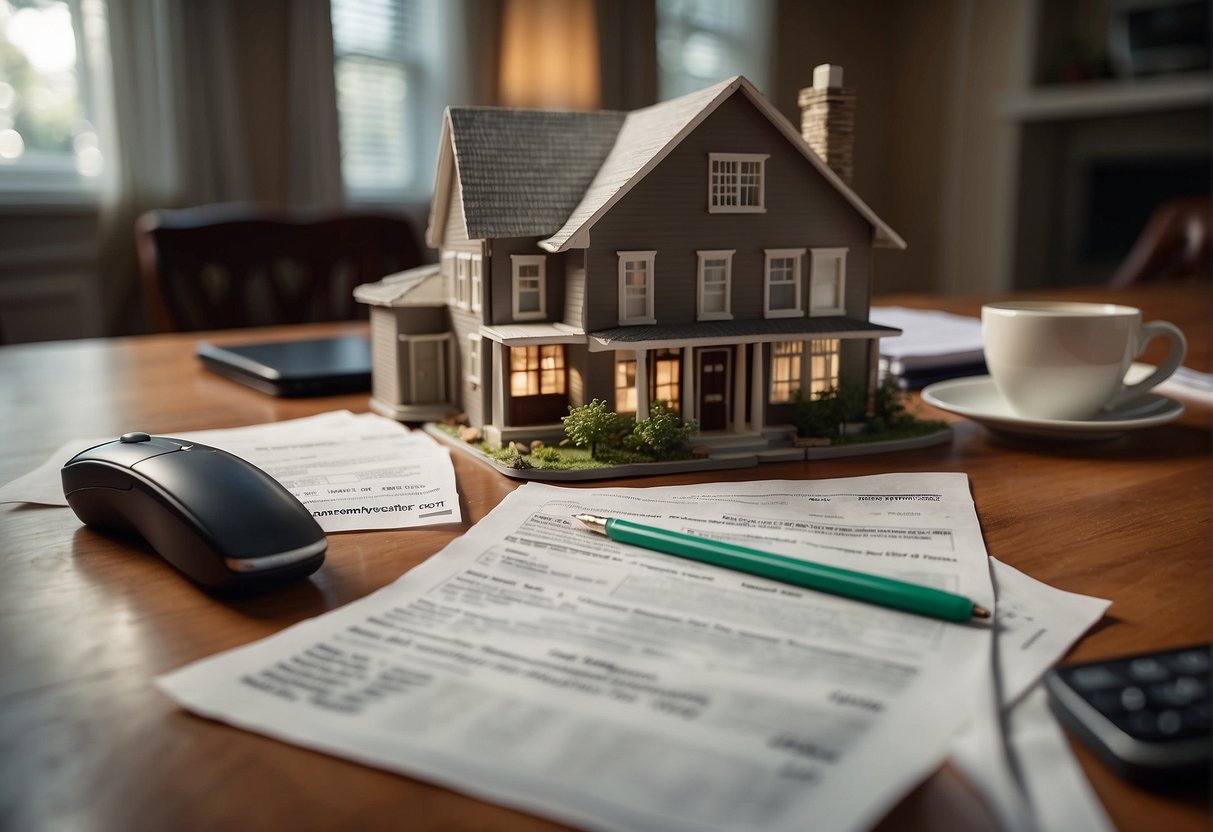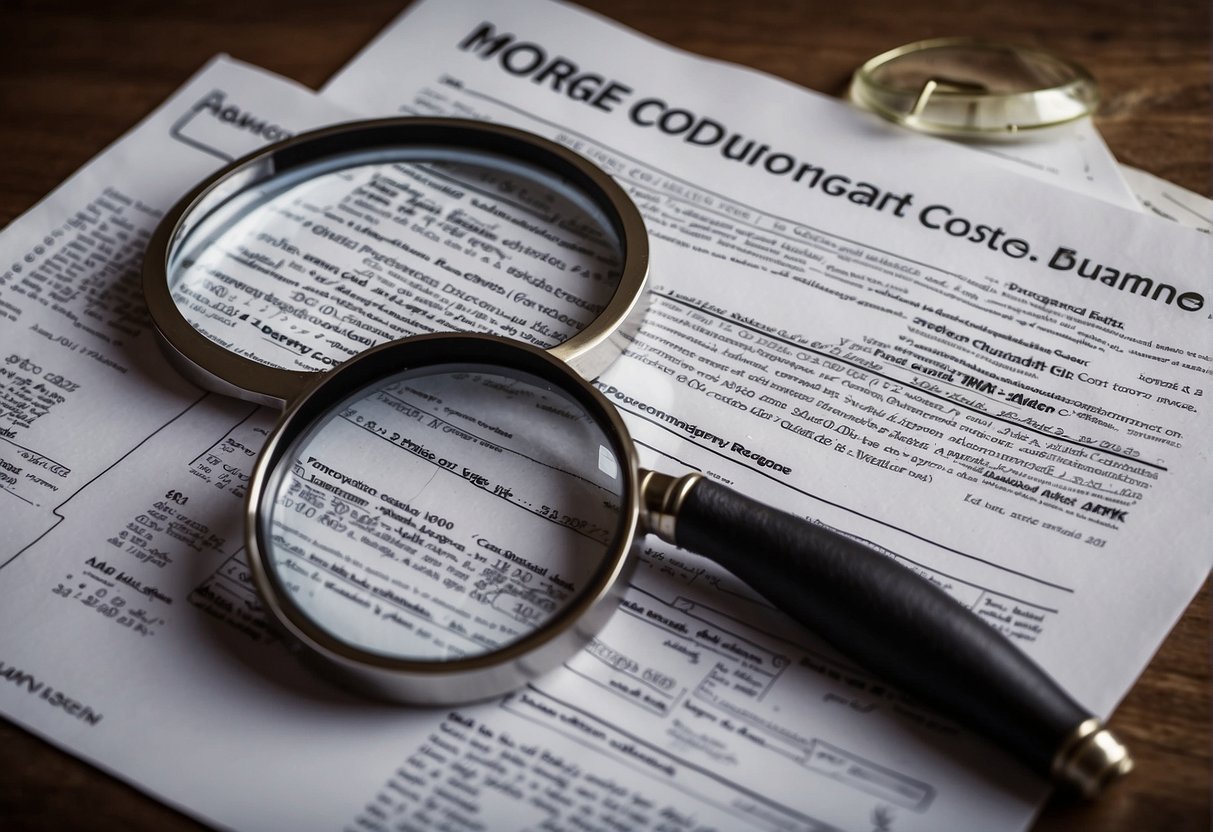
Hidden Costs in Mortgages: Uncovering the Sneaky Fees
Owning a home is a dream for many, but navigating the complex world of mortgages can feel like a minefield. The process of securing a mortgage involves more than just making monthly payments. There are hidden costs that may take unsuspecting borrowers by surprise, making it crucial to be aware of these expenses to prevent financial setbacks in the future.

Mortgages come with various upfront and long-term costs, some of which can be overlooked during the home buying process. It’s important to have a full understanding of these costs and how they can affect your overall financial situation. By staying informed and preparing for these potential hidden costs, potential homeowners can make smart mortgage decisions.
Key Takeaways from Hidden Costs in Mortgages
- Be aware of hidden costs in mortgages, both upfront and long-term
- Understanding mortgage payments and additional expenses is crucial
- Stay informed to make smart mortgage decisions and manage your finances effectively
Understanding Mortgage Payments
Principal and Interest
When it comes to mortgage payments, there are a few key factors to consider. Firstly, you need to understand the principal and interest components of a mortgage payment. The principal is the amount borrowed initially, while the interest is the cost of borrowing that money. Mortgage payments are typically divided into two parts: principal and interest. The principal goes toward reducing the amount you owe, while the interest is the cost of borrowing the remaining balance.
Interest rates can differ significantly depending on various factors, such as your credit score, down payment, and the type of loan you choose. Generally, the higher the interest rate, the more you’ll pay in interest over the life of the loan. It’s essential to compare different loan options and interest rates to ensure you’re getting the best deal.
Monthly Mortgage Payment Breakdown
Aside from principal and interest, your monthly mortgage payment may also include other costs like escrow, homeowners insurance, and property taxes. Here’s a brief breakdown of these additional expenses:
Escrow: An escrow account is basically a holding account that some lenders require borrowers to have. It’s used to collect and hold funds for the payment of property taxes and homeowners insurance. These taxes and insurance costs are then paid by the lender on the borrower’s behalf.
Homeowners Insurance: This is a type of insurance that covers damage to your property and provides liability coverage if someone is injured on your property. The cost of homeowners insurance depends on various factors like the value of your home, the location, and the coverage options you choose.
Property Taxes: These are taxes imposed by local governments based on the value of your property. Property tax rates can vary significantly depending on the location of the property and the local tax laws.
Here is a sample breakdown of a monthly mortgage payment:
| Component | Description | Estimated Monthly Cost |
|---|---|---|
| Principal | Initial loan amount | $750 |
| Interest | Cost of borrowing the remaining loan balance | $450 |
| Escrow | Funds collected & held for payment of property taxes and homeowners insurance | $150 |
| Homeowners Insurance | Insurance that covers property damage and provides liability coverage | $50 |
| Property Taxes | Taxes imposed by local governments based on property value | $100 |
| Total | Monthly mortgage payment (Principal + Interest + Escrow + Homeowners Insurance + Property Taxes) | $1,500 |
By understanding the components of your monthly mortgage payment, you can better prepare for homeownership and create a budget that works best for you.
Upfront Costs of Home Buying
When it comes to buying a home, there are several upfront costs to consider. Two of the most important of these to keep in mind are the closing costs and the down payment. In this section, we’ll take a closer look at these expenses and how they factor into your overall mortgage experience.
Closing Costs
Closing costs are an assortment of fees and charges that are typically paid at the time of closing on your mortgage. They can include items such as the appraisal fee, loan origination charges, and home inspection expenses. It’s important to be prepared for these costs, as they can add up to as much as 5% of your total home loan. Some examples of closing costs include:
- Appraisal fee: This fee is paid to obtain a professional appraisal of the property’s value. It ensures that the purchase price is fair and accurate.
- Home inspection: A home inspection is conducted by a certified inspector to identify any potential issues with the property before closing. This can help buyers avoid costly surprises down the line.
- Loan origination fees: These are fees charged by lenders for processing and underwriting your loan application.
To avoid surprises when closing on your mortgage, make sure to research and understand all potential closing costs.
Down Payment
Another key upfront cost to consider in the home-buying process is the down payment. The down payment is the amount of money you pay upfront at the time of purchase, which is typically expressed as a percentage of the home’s total price. A higher down payment can result in a lower mortgage balance and potentially reduced monthly payments. Some general points to consider regarding down payments include:
- Most mortgage lenders require a down payment of at least 3.5% to 20% of the purchase price.
- If your down payment is less than 20%, you may be required to pay for private mortgage insurance (PMI), which can increase your monthly payments.
- Larger down payments can lead to better interest rates and lower monthly mortgage payments.
When budgeting for your home purchase, it’s essential to factor in both closing costs and down payments as part of the overall equation. This can help you be better prepared and ensure that you’re able to make informed decisions when moving forward in the home-buying process.
Recurring Homeownership Expenses

When considering a mortgage, it’s essential to keep in mind the ongoing costs that come with homeownership. These expenses are not just one-time payments but continue to arise throughout the time you own the property. This section will cover three significant categories of recurring homeownership expenses: property taxes, insurance premiums, and HOA and condo fees.
Property Taxes
Property taxes are an unavoidable part of owning a property. They are calculated based on the assessed value of a property, which can vary depending on the local government’s assessment methods and tax rates. It’s crucial to be aware that property taxes can, and often do, increase over time.
Owners often pay property taxes through an escrow account, established by the lender. The escrow account collects a portion of the tax each month, ensuring that funds are available to pay the full amount when it’s due.
Insurance Premiums
Another essential recurring expense is insurance. There are two main types: homeowners insurance and mortgage insurance. Homeowners insurance covers costs related to damages to the property in case of disasters, theft, or accidents. Most mortgage lenders require borrowers to have homeowners insurance as a condition for loan approval.
In cases where the down payment is less than 20% of the home’s price, lenders may also require private mortgage insurance (PMI). PMI protects the lender in case the borrower fails to make their mortgage payments, leading to a foreclosure. PMI rates depend on the size of the down payment and the borrower’s credit score. It is essential to keep in mind that PMI is an additional monthly cost until the borrower reaches 20% equity in their home.
HOA and Condo Fees
Lastly, some homeowners may have to pay fees to a homeowners association (HOA) or a condominium association. These fees are typically found in planned communities or condominium buildings. The funds collected go towards maintaining common areas, providing amenities, and handling property management tasks.
HOA and condo fees can range from a few hundred dollars to thousands of dollars per year, depending on the community and its provided amenities. While these fees may seem high, they can sometimes save homeowners money by taking care of certain services that they would otherwise have to handle themselves.
It is essential to consider the potential impact of these recurring expenses on your monthly budget when deciding on a mortgage. By being aware of and prepared for these costs, homeowners can better ensure they remain financially stable and capable of maintaining their mortgage payments.
Hidden Costs in Long-Term Ownership

Maintenance and Repairs
Long-term homeownership comes with the inevitable need for maintenance and repairs. Regular home maintenance tasks, such as cleaning gutters, resealing decks, and servicing HVAC systems, can add up over time. In addition to routine duties, homeowners may also face larger repair jobs involving the roof, plumbing, or electrical systems.
For example, the average lifespan of a roof ranges from 20 to 30 years. After that period, a roof replacement could become necessary, costing thousands of dollars. Similarly, plumbing and HVAC systems require regular upkeep to maintain their reliability and efficiency. Homeowners should budget for these expenses and anticipate potential repairs to avoid financial surprises in the long run.
Unexpected Expenses
Owning a home can also involve a variety of unexpected expenses, some of which may not be apparent to first-time buyers. Beyond maintenance and repairs, homeowners should be prepared for costs such as:
- Property tax increases
- Higher utility bills
- Upgrades to meet building codes
- Pest control
- Landscaping
Moreover, homeowners may face unplanned and more pressing issues, like water damage, mold, or foundation problems. These challenges can be costly to address and essential to remedy immediately. The 11 Unexpected & Hidden Costs of Buying a Home article offers valuable insights into such expenses, helping homeowners better understand and anticipate potential financial pitfalls related to long-term home ownership.
Loan-Specific Hidden Costs

When it comes to mortgages, there are certain loan-specific hidden costs that you should be aware of. Knowing what these costs are can help you make a more informed decision when choosing a mortgage provider.
Loan Origination and Underwriting Fees
Loan origination fees are charged by lenders for processing your mortgage application. These fees cover the lender’s costs for evaluating your creditworthiness and preparing your loan paperwork. Underwriting fees, on the other hand, are associated with the lender’s assessment of the risk involved in lending you money. Both of these fees can vary between lenders, making it essential to shop around and compare the costs.
A significant portion of your mortgage closing costs is made up of loan origination and underwriting fees. Keep in mind that some lenders might bundle these costs under a single fee, while others may itemize them separately. It’s important to carefully review the Loan Estimate document provided by your lender to understand all of the fees involved in your mortgage.
Mortgage Points and APR
Mortgage points, also known as discount points, are essentially prepaid interest on your loan. By purchasing points, you can lower your ongoing interest rate, potentially saving you a lot of money over time. However, buying mortgage points can mean a higher upfront cost. It’s crucial to determine whether the long-term savings are worth the initial expense.
To make a more accurate comparison between loan offers, consider taking the annual percentage rate (APR) into account. The APR includes both the interest rate and any additional costs, such as mortgage points, origination fees, and underwriting fees, that the lender charges for your mortgage. By evaluating your loan offers based on the APR, you can get a more comprehensive understanding of the overall cost of each option.
In summary, understanding the various loan-specific hidden costs in mortgages is essential for making well-informed decisions. Make sure to carefully review all loan-related documents and ask your lender any questions you may have about the fees. Don’t be afraid to shop around and compare loan offers to find the right mortgage for you.
Managing Your Mortgage Effectively

Avoiding Hidden Fees
When it comes to managing your mortgage, it’s essential to stay aware of any hidden costs that may come your way. These fees can sometimes be tucked away in the fine print of your home loan and can catch you off guard, adding up quickly over time.
To avoid these hidden fees, it’s crucial to maintain a thorough understanding of your mortgage payment terms and any additional expenses involved. It’s wise to create a budget that accounts for mortgage insurance, monthly mortgage payments, and any other related costs to keep finances in check.
In addition, ensure you work with a reputable mortgage professional or bank to avoid unexpected surprises, as they can help you navigate the complex world of home loans.
| Checkpoint | Tips |
|---|---|
| Understand terms | Read the fine print on your loan documents |
| Budgeting | Account for all expenses in your mortgage |
| Choosing lenders | Work with reputable banking professionals |
Negotiating with Lenders
Once you have a good grasp of all the costs involved, you can then take a proactive approach to negotiating with lenders. This can potentially save you a significant amount of money on your home loan, as well as help you avoid hidden fees down the road.
Start by researching and comparing various mortgage offers to help you gain a solid understanding of the market. This information will be valuable during negotiations when discussing rates and terms with different banks and mortgage professionals.
Remember, you have the right to ask questions, request clarification on any terms or fees, and negotiate better conditions for your loan.
Keep in mind the following when negotiating:
- Your credit score can play a significant role in the offers you receive. It’s essential to maintain a good credit history.
- Being well-prepared for meetings with lenders. Bring all necessary documents and be ready to discuss details with confidence.
By taking the initiative to actively manage your mortgage and avoiding hidden fees, you’ll be well on your way to a successful home loan experience without any unwelcome surprises.
Additional Financial Considerations

Home Equity Dynamics
When it comes to homeownership, it’s essential to consider the dynamics of home equity. Home equity is simply the difference between the market value of a property and the outstanding mortgage balance. As you pay off your mortgage, your equity increases.
However, there are hidden costs associated with home equity that often go unnoticed. For example, the home equity line of credit (HELOC) allows homeowners to borrow money using their home equity as collateral. While it can provide an extra source of funds, it also has risks and costs, such as interest rates and fees.
Additionally, changes in the real estate market can impact home equity. When property values decline, homeowners may find themselves in a negative equity situation, meaning their mortgage balance is higher than the home’s worth. This can cause financial stress and lead to difficulties in selling or refinancing the property.
Investment Perspective on Homeownership
From an investment standpoint, homeownership costs and hidden costs should be considered before diving into the world of real estate. Here are a few things to keep in mind:
Equity Accumulation: As you pay down your mortgage and build equity, you get closer to owning your home outright. This may eventually create opportunities for leveraging your property for additional investments.
Appreciation Potential: The value of your home might grow over time, providing you with an increase in net worth. However, this is not guaranteed and depends heavily on market conditions.
Hidden Costs: There are various hidden costs of homeownership that can impact your overall investment potential. Examples include:
- Property taxes
- Homeowners Association (HOA) fees
- Maintenance and repairs
- Utilities and insurance
It’s essential to analyze all these factors before deciding if homeownership is an appropriate investment for your financial situation. By keeping these additional financial considerations in mind, you’ll be prepared to make a truly informed decision about your next real estate endeavor.
Impact of External Factors

Market Fluctuations
Market fluctuations can significantly affect real estate and mortgage rates. When there is a high demand for property and a surplus of buyers, prices tend to increase. This leads banks to adjust their interest rates, as they become more cautious in their investments. As a result, borrowers might struggle to find competitive rates.
On the other hand, during a downturn in the housing market, property prices can drop dramatically. This may lead to lower mortgage rates as banks try to attract borrowers. However, be cautious when entering the market as property values can continue to decline. Staying informed about current market data can be helpful in making a well-informed decision.
Interest Rate Variability
Another significant external factor to consider is interest rate variability. Banks determine their mortgage rates based on the interest rates set by central banks, such as the Federal Reserve in the United States. These rates are often influenced by economic factors, such as inflation and unemployment rates.
Fixed-rate mortgages – The interest rate remains the same throughout the term of the loan, which ensures consistent monthly payments. However, this means that if current interest rates drop, borrowers might be stuck paying more than the current market rate.
Adjustable-rate mortgages (ARMs) – The initial interest rate is usually lower than that of a fixed-rate mortgage, but it can change over time based on market conditions. The benefit is that borrowers can potentially take advantage of lower interest rates in the future. The downside is that payments may increase if rates rise. It’s vital to understand the terms of your ARM, including rate adjustment frequency and caps.
In conclusion, market fluctuations and interest rate variability are essential factors for borrowers to consider when seeking mortgages. Staying informed of market data is crucial for making well-informed decisions about home loans. Being aware of the various mortgage options and their potential risks can help borrowers secure the most competitive rates and protect themselves from unforeseen changes in interest rates.
Preparing for the Unseen

Building an Emergency Fund
An important aspect to consider when taking out a mortgage is building an emergency fund. This is a cash reserve that can be used to cover unexpected expenses or situations that may arise. For instance, a homeowner might face sudden repairs, which are quite common in older homes. To be prepared for such unforeseen circumstances, it’s wise to have a safety net in place. A good rule of thumb is to have three to six months’ worth of living expenses saved up.
Costs Beyond the Mortgage
Homeownership brings with it many financial obligations beyond the mortgage payment:
Utilities: The cost of electricity, gas, water, and other utilities can sometimes be overlooked. Generally, these expenses are higher for homeowners than renters, due to factors like larger living spaces and yard maintenance.
Lawn care: The responsibility for maintaining a yard often falls on the homeowner. This expense should be factored into the budget, as hiring professionals or purchasing lawn care equipment can be costly.
Miscellaneous fees: Homeowners may encounter additional fees, such as homeowners’ association dues or condominium association fees. These can sometimes be a substantial ongoing expense.
Moving costs: When preparing to move into a new home, homeowners should account for the expenses of redirecting mail, hiring movers, and furnishing their new space.
Hidden fees: Closing costs are just the tip of the iceberg when it comes to fees associated with a mortgage. Some other potential costs include property taxes, insurance, and maintenance fees.
Here’s an example of how these additional expenses might break down:
| Expense | Amount Per Month |
|---|---|
| Utilities | $150 – $300 |
| Lawn Care | $75 – $150 |
| Miscellaneous Fees | $50 – $200 |
| Moving Costs | Varies |
| Hidden Fees | Varies |
By planning for hidden costs and unexpected expenses, homeowners can be more financially stable and better prepared for a stress-free future. Regularly reviewing and updating the budget, as well as maintaining an emergency fund, can greatly help in managing these extra costs effectively.
Don’t Know Where To Turn?
If you’re seeking help, feel free to consult our recommended mortgage professionals: Central Bank, Brooke Gagliardi, and AMC Mortgage, Gordon Chandler. These two are always prepared to provide expert guidance on navigating the mortgage landscape. As always, OKCHomeSellers at McGraw Realtors stands ready to help. Just contact us!
Luxury Specialist at McGraw Realtors
With a diverse background, including a career as an Air Force fighter pilot and entrepreneurship, Bill transitioned to real estate in 1995. Co-founding Paradigm Realty with his wife, Charlene, he quickly rose to prominence in Oklahoma City’s luxury real estate scene. Now, as one of the top agents with annual sales surpassing $20 million, Bill’s dedication to exceptional service remains unparalleled. With a legacy spanning over two decades in the industry, Bill’s expertise and commitment make him a trusted name in luxury real estate.